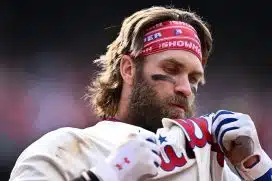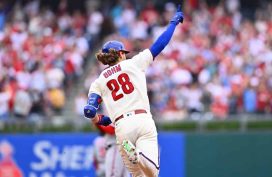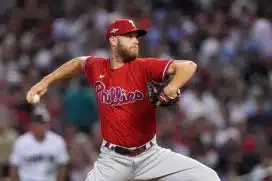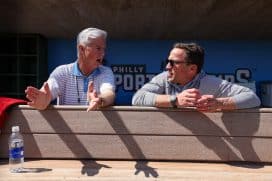We are here, on the eve of 2020. While much of the Philadelphia sports world has been reminiscing in the form of top 10 moments (check out the Top 10 sports moments of the decade on 973espn) I thought I might go in a different direction. The 2010s started out on top for the Phillies, but for the most part have been disappointing.
Since making the playoffs in 2011 with the best record in franchise history, the Phillies have missed the eight years since. Things are more promising moving forward, but for now, here are the 10 worst Phillies moments of the decade.
10. Phillies Sign Jonathan Papelbon to a Four-Year, $50 million contract
The performance in terms of baseball was not the problem with this deal. Papelbon became the game's top-paid closer in baseball history at the time (Mariano Rivera would soon pick up that distinction). Papelbon never seemed to connect with the fans.
"I didn't come here for this", Papelbon notoriously said one day in 2013, as the Phillies were in the midst of a second mediocre year in a row. The fans were not paying for mediocrity either, but the statement rubbed fans the wrong way.
Papelbon's tenure just under a year after being suspended seven games for a gesture he called an "adjustment". Papelbon somehow was traded in 2015 to the Washington Nationals for an actual prospect (Nick Pivetta). In Washington he infamously choked Bryce Harper in a dugout altercation.
9. The Phillies Pass on a Trade for Starter Cole Hamels, Fall Out of Playoff Contention
Former Phillies ace Cole Hamels was very much available for a trade at the 2018 trade deadline. The acquiring team did not need to pick up an option after that season, so the commitment was low. The Phillies were in playoff contention at the trade deadline, but decided to pass on Hamels.
The Chicago Cubs sent three players to the Texas Rangers for Hamels, none of whom were necessarily major prospects. In return, the Cubs got Hamels and $5 million to help pay his salary.
Hamels went 4-3 with a 2.36 earned run average for the playoff-bound Chicago Cubs. The Phillies young starting staff floundered and the club finished two games under the .500 mark for the season, missing the playoffs. Hamels was so good that the Cubs picked up his option for 2019, which at one point seemed like it would never happen.
8. Phillies Start Rebuilding…Too Late
This one involves Cole Hamels, too. The Phillies rebuild finally got underway for the 2015 season. The first move of a rebuild was the trade of shortstop Jimmy Rollins to the Los Angeles Dodgers in December for Zach Eflin and Tom Windle. Hamels would be moved in a July deadline trade to the Texas Rangers that brought back young pieces Nick Williams, Jorge Alfaro, Jerad Eickhoff and Jake Thompson.
But by the time these trades took place, the Phillies were well beyond the expiration date on valued veterans. Instead of trading Cliff Lee in 2013 when he had trade value, they ended up with an injury-plagued 2014 season and he never once pitched in 2015, the final year of a five-year deal he signed in December of 2010. The returns for Rollins and later Chase Utley were much less this late.
2016 and 2017 were a Phillies wasteland, while 2018 showed some promise, but was not very fun, either. 2019 was a .500 season and the Phillies are still waiting for the postseason. Could they have acquired some young assets sooner, might they have returned to contention sooner?
7. Jeff Francoeur, Bob McClure, and the White Flag
It was an ugly 19-3 loss for the Phillies in Baltimore. Before it was totally in vogue, utility man Jeff Francoeur took the mound for the Phillies. After a solid first inning of relief, Francoeur went back out for another inning. It did not go well.
The fatigued Francoeur needed to get out of the game. The dugout supposedly knew it, but the story was that the bullpen phone was not working. McClure waved a white towel trying to get the bullpen's attention. When McClure came out to the mound for a visit, Chase Utley expressed his great discontent with McClure and the Phillies coaching staff for leaving Francoeur out there.
That may be what McClure is best remembered for.
6. The Phillies Outright Domonic Brown Off Of the 40-man Roster
This roster move itself was not necessarily a "moment" that was terrible in itself; fans had hoped for such a move. But the underachieving Domonic Brown was an untouchable prospect, ranked second to Mike Trout on top prospect lists for an extended period of time, and did not produce in the major leagues.
The lone exception was the month of May in 2013, when Brown hit .303 with 12 home runs, drove in 25 and was subsequently named to the National League All-Star team. Brown was never able to come close to that. When the Phillies were putting together their 2016 team, they decided to leave Brown off of it. The Phillies instead brought David Lough and Cedric Hunter to camp. Brown signed with the Toronto Blue Jays but never made it back to the major leagues.
Brown was last seen playing in the Mexican League.
5. Ryne Sandberg Unleashes an Angry Tirade to Ken Giles
The Phillies brought Ryne Sandberg back to the organization after he lost out on a Chicago Cubs managerial opening to Mike Cubbage. After managing at Triple-A Lehigh Valley, Sandberg was named Phillies third base coach and then manager after Charlie Manuel was let go in the middle of the 2013 season.
The moment that describes Sandberg's tenure as Phillies manager best would be one night in Pittsburgh in June of 2016. Closer Ken Giles was not throwing what the coaching staff wanted to. Sandberg finally had enough.
Sandberg unleashed a visible tongue-lashing to his closer that was so loud it could be heard back in Philadelphia. It was perhaps the most emotion that Sandberg had shown as the Phillies manager. While minor leaguers such as Kevin Frandsen spoke highly of his former manager at Triple-A, he never found the success, or more importantly, respect of his players in Philadelphia.
Two weeks after this incident, with rumors swirling that the Phillies were going to be hiring Andy MacPhail to be the club President (with whom he was well familiar in Chicago), Sandberg resigned from his managerial role, and has not held a coaching position since.
4. Phillies Trade Hunter Pence to the San Francisco Giants
"The Next Great Phillie" read the cover of Philadelphia Magazine, with an accompanying piece penned by John Gonzalez. When Hunter Pence came to Philadelphia, he was an instant fan favorite. The Phillies paid what was seen as a high price to acquire him from the Houston Astros (though in the end, none were star major league players), and about a calendar year later traded him to the San Francisco Giants.
This was the one rebuild-like trade the Phillies actually made. The Phillies felt they got their heir to Carlos Ruiz in Tommy Joseph. They also brought back Nate Schierholtz, who had fallen out of favor with the Giants, and Seth Rosin, who had a cup of coffee in the major leagues with a few clubs.
Concussions kept Joseph from being a catcher in the major leagues, though his bat would have been sufficient if he had stayed behind the plate. Joseph did see some time at first base for the Phillies. But the real value Joseph brought was behind the plate, and blocked by Buster Posey, the Giants were willing to trade him.
However, the Phillies did not really replace Pence heading into 2013 when they were expected to contend.
The Opening Day right fielder for the Phillies in 2013 was none other than Delmon Young. Phillies general manager Ruben Amaro, Jr. expected that the Phillies would sign some free agents and make a run, but Young was a gamble more than a sure bet. That gamble failed.
3. Charlie Manuel is Fired as Phillies Manager
The Phillies glory years officially ended on August 16, 2013, when Charlie Manuel was fired by the Philadelphia Phillies. It was not the usual way a manager goes out. The Phillies media never did hear from Gabe Kapler upon his dismissal. But Manuel took the podium with general manager Ruben Amaro, Jr. and spoke about how sad he was to lose his job. "I'm mad they took the best seat in the house away from me, Manuel said. Amaro cried.
But the moment was not just sad because Philadelphia was losing a beloved figure. In fact, Manuel would return to the organization shortly thereafter and even picked up a six-week stint as hitting coach in 2019. With Manuel out, the glory years of the Philadelphia Phillies were over.
The Phillies did try to win in 2014, signing the likes of Marlon Byrd and A.J. Burnett, players who only cost them money and not draft picks or talent in trade. But the Phillies would never be the same.
2. Cliff Lee Blows 4-0 Lead in 2011 NLDS
The finale of this 2011 NLDS was a brilliant pitcher's duel between Chris Carpenter and Roy Halladay. Halladay allowed just one earned run in the first inning, and after that, Halladay and his good friend Carpenter matched zeroes the rest of the way, before the Phillies lost (more on that in a minute).
But in Game 2, the Phillies spotted newly-signed $124 million ace Cliff Lee a four-run lead. That would be enough, right?
Lee allowed the leadoff hitter to reach base four out of the seven innings he began. Spotting a team like the Cardinals base runners would not be conducive to any team winning. But alas, Lee blew the lead, the Phillies lost, and the series ended up going five games.
That takes us to the worst moment in the decade.
1. Ryan Howard Ruptures Achilles as the Phillies are Eliminated from 2011 Playoffs
October 7, 2011. The best Phillies team ever, record-wise was squaring off with the St. Louis Cardinals for Game 5 of the National League Division Series. The winner of the game would advance to the National League Championship Series. Having lost in the National League Championship Series to the San Francisco Giants the year prior, the Phillies loaded up with Cliff Lee and added Hunter Pence to be sure they would win this time.
At the end of the game, after the aforementioned pitchers duel between Roy Halladay and Chris Carpenter, the game came down to the final out. Their slugger came to the plate. First baseman Ryan Howard came up, hoping for a last-minute miracle.
Instead, the exact opposite happened.
Howard swung and immediately ripped his Achilles tendon. This would be the final out by what was perhaps the best Phillies team in all of team history. But they would not win. Howard's career would not be what it used to. 50,000 people at Citizens Bank Park were dead silent.
With a power-threat like Howard relying strongly on his legs to drive the ball, Howard never could plant his foot again the way he used to. Howard would return in late 2012, still hit some home runs, but Howard was never the same. The Phillies were never the same.







